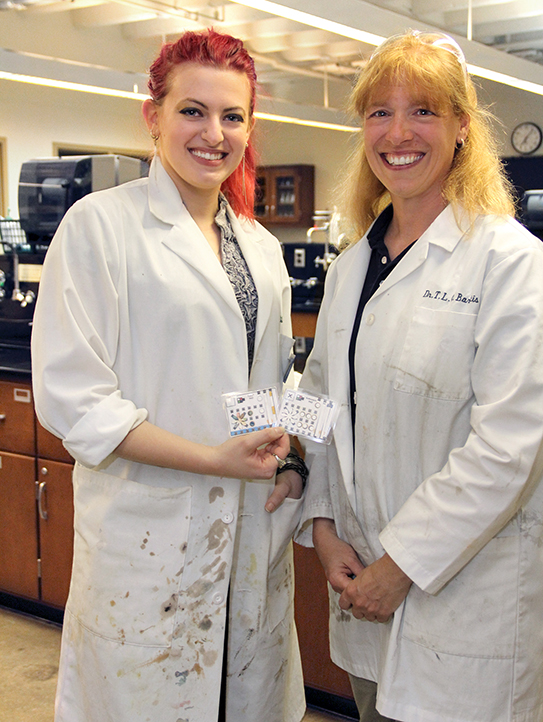Saint Mary’s College Receives Second Patent for Paper Analytical Device Technology
March 27, 2017 (Notre Dame, Ind.) — The U.S. Patent and Trademark office has issued a second patent to Saint Mary’s College for paper analytical device (PAD) technology that detects ingredients found in low quality or counterfeit pharmaceuticals.
“These are life-saving innovations that have grown out of collaborations between faculty and students. Their cutting-edge work to improve public health represents the Saint Mary’s mission in action,” said President Jan Cervelli.
Low quality or counterfeit drugs are a profound problem in developing countries where fake drugs are marketed as cures for infections, diseases, or infestations. The PADs, made of chemically-treated paper — about the size of a business card — are user-friendly, inexpensive, and effective. Saint Mary’s chemistry professor Toni L.O. Barstis is an inventor on both patents. The second one, US Patent No. 9,555,274, also lists Mary Bevilacqua ’12 of Denver, CO, who assisted in the research as an undergraduate, as an inventor.

“It is very rare for an undergraduate student to be named as an inventor, but the PADs Project is no ordinary undergraduate research project,” Barstis said. “We’ve been doing PADs research for more than seven years and each student researcher, past and present, has been driven by her desire to combine their scientific education with that of service.”
The second generation PAD contains vessels, or thin tubes, which hold chemicals that are released when the user bends the PAD and breaks the vessels. Bevilacqua got the idea from glow sticks, which are activated (glow in the dark) when bent. “My goal was to adjust the PAD to meet the needs of the chemistry,” Bevilacqua said.
The College received a patent last year for a PAD invented with the University of Notre Dame. These are the first two patents in Saint Mary’s 173-year history, and the first patent issued exclusively to Saint Mary’s.
Research at this level takes significant dollars and years of commitment. Jen Mathile Prikkel ’95 and her family have been instrumental to the success of the research.
“The Jen and Pat Prikkel Fund at the Mathile Family Foundation infused the PADs Project with resources that ensured research would continue,” Barstis said. “Thanks to this investment, we have two patents and are much closer to getting this technology to market where it can be used by pharmacists and other health professionals to expose the global health problem of low quality drugs.”
Additional funds allow for the expansion of PADs research. Barstis, Saint Mary’s biology professors Don Paetkau and Reena Lamichhane Khadka, and Notre Dame professor of chemistry and biochemistry Marya Lieberman were awarded a National Science Foundation grant to fund three years of summer research. These combined funds will support two cohorts of faculty-student groups: one to travel throughout Nepal and Kenya to collect samples of select pharmaceuticals and drinking water for PADs analyses and the other to stay home to focus on development, validation, and image analysis of PADs. Physics professor Ian Bentley, chemistry professor Chris Dunlap, and technologist Dave Barstis complete the team of Saint Mary’s investigators.
